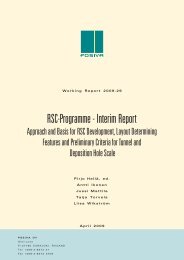32Figure 27. Three-dimensional surface picked from the lines S312, S432, S28, S29, S30,S31 <strong>and</strong> S43.The time picked surfaces, recognised from several parallel <strong>and</strong> crossing lines, werecorrected for <strong>of</strong>fset <strong>and</strong> <strong>of</strong>fline reflection geometry. The original picks are displayed onthe sections with their apparent dips (see APPENDIX 1). The observations aregeometrically tilted so, that the shortest distance from CDP is measured along thenormal <strong>of</strong> the reflection plane (reflector is tilted towards the up-dip direction). Thiscorresponds roughly a 3D migration, but is a simplified procedure (Prissang et al.2004). Table 4 shows the information on the corrected surfaces. Surfaces are displayedin Figure 28.In Figure 44 in APPENDIX 1 is shown an interesting breakout <strong>and</strong> discontinuity <strong>of</strong> areflecting surfaces ref 9 <strong>and</strong> ref 10, indicating possible vertical displacement along asubvertical fault. The apparent diffracted velocities near the event match to Stoneleyarrivals.
33Table 4. Positions <strong>and</strong> dips for migrated three dimensional surfacesSurfacenameDip direction/ Dip(degrees from North<strong>and</strong> Horizontal)Two waytravel time(ms)Depth (m)Picked from the linesref 1 134,30 N/ 16,18 416 -723,8…-623,3 48, 50, 362, 372ref 2 275,16 N/ 63,91 178 -199,8…-131,2 50, 362ref 3 140,32 N/ 18,79 322 -284,5...-251,5 342, 47ref 5 130,87 N/ 11,51 421 -333,7...-273,9 312, 432, 28, 29, 30, 31, 43ref 6 109,62 N/ 33,59 374 -499,0...-419,2 28, 29, 29, 30ref 7 89,22 N/ 10,66 344 -205,8...-162,5 28, 29ref 8 147,09 N/ 8,29 329 -685,4...-664,1 29, 43ref 9442, 44, 282, 45, 322, 312,46, 302115,20 N /17,86 417 -305,2...-192,0ref 10 128,74 N/ 14,52 439 -252,5...-186,7 442, 302, 45, 46, 312ref 11 138,74 N/ 15,43 423 -298,2...-243,5 432, 322, 45ref 12 219,34 N/ 18,21 427 -331,7...-252,0 342, 47, 35, 48, 45ref 13 226,95 N/ 23,26 435 -350,0...-301,44.3 Comparison to borehole dataThe picked <strong>and</strong> geometrically corrected surfaces were transported to AutoDeskenvironment, where they were displayed with other available data. In Figure 28,Figure 30, <strong>and</strong> Figure 31 are shown the corrected surfaces, boreholes <strong>and</strong> otherrelevant information. The depth match <strong>of</strong> the reflecting surfaces with boreholeobservations indicate that selected velocity <strong>of</strong> 5000 m/s can be assumed to be suitableor almost suitable for the processing. In Table 5 are shown boreholes intersecting thesurfaces. The actual velocities deeper in the rock mass are at range 5600-5750 m/s(Enescu et al. 2004), but the approximation used in processing takes into account thelower velocities near surface at 0…150 m depths.Six different groups <strong>of</strong> reflectors were deduced.1. Reflectors ref1 <strong>and</strong> ref8 are dipping gently to the southeast (134-147/8-16), <strong>and</strong>are located at 600-700 m depth level. Their corresponding structure category isHZ21. Reflectors found 30-50 m above the indications.2. Almost similarly oriented ref6, intersecting KR29 (485 m), <strong>and</strong> located 50-100m above ref1-ref8 or HZ21 (may form a part <strong>of</strong> it) at depth level 420-500 m3. Reflectors ref3, ref5, ref9, ref10 <strong>and</strong> ref11 form a group showing slightlydiscontinuous character <strong>and</strong> varying orientations 128 -140/11-19 in differentlocations, <strong>and</strong> forming upper (ref3, ref10, ref11) <strong>and</strong> lower surface (ref5, ref9).Corresponding structures are HZ20A or BFZ098 <strong>and</strong> HZ20B.4. Almost similarly oriented ref7 (89/11) at 150-200 m depth levels near KR29, asprojected would be some 40 m above the level <strong>of</strong> HZ20A, <strong>and</strong> may indicatedisplacement in the level <strong>of</strong> corresponding structures.5. Ref12 <strong>and</strong> ref13, dipping gently to the SW, <strong>and</strong> met in slightly deviating twoparts in KR22, KR23, KR25 <strong>and</strong> KR28 at depth levels 320 – 460 m, at 30 m
















